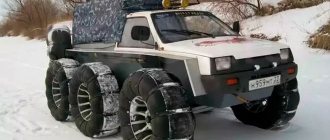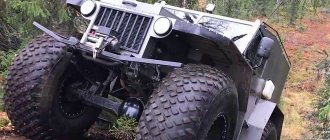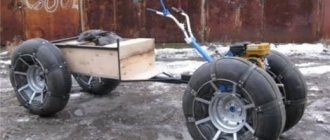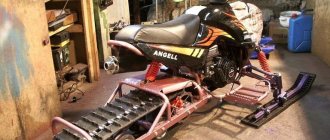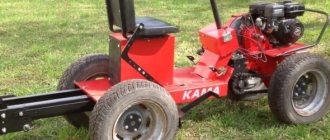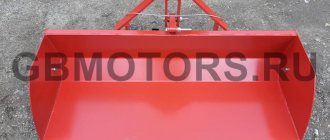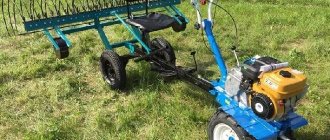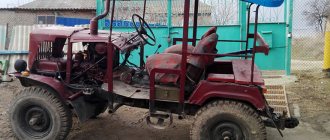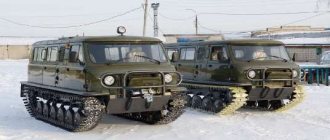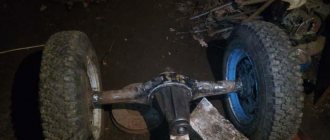The mini-all-terrain vehicle must overcome road obstacles, water obstacles, and swamps. To do this, it needs: a powerful engine, a robust design, and a reliable tracked or wheeled drive. Car enthusiasts assemble such vehicles with their own hands based on their existing cars or buy ready-made kits for production.
What are homemade products?
At the preparation stage, it is necessary to decide whether the equipment will be used on public roads.
In this case, it is necessary to obtain registration documents and state license plates from the traffic police according to the standard procedure.
The vehicle must comply with current safety standards, which is confirmed by the results of certification tests.
Self-assembled all-terrain vehicles for off-road travel can be registered with Gostekhnadzor according to the following scheme:
- develop technical specifications;
- collect documents confirming rights to the power unit and other functional units;
- undergo the certification procedure at a specialized enterprise.
The collected documents are submitted for registration of a self-propelled vehicle passport. Failure to register is punishable by a fine of 1,500 to 2,000 rubles. for individuals.
If you do not take into account the official requirements of safety standards, the manufacturer of the homemade product has the right to use any design solutions:
- install 10 wheels or choose the classic 4x4 formula;
- Instead of a manual transmission, install a comfortable automatic transmission.
All-terrain vehicles equipped with auger-rotor propulsors have high cross-country ability.
However, in practice, 2 SUV schemes are most often used:
- on tracks;
- on pneumatic tires with low pressure.
To reduce the cost of the project and ease of maintenance, the homemade product is equipped with a manual gearbox and simple control devices. When creating drawings, it is recommended to objectively evaluate your own knowledge and skills in order to eliminate errors along with excessive difficulties during the assembly process.
On caterpillar tracks
Vehicles in this category differ:
- good maneuverability;
- limited speed characteristics;
- increased fuel consumption;
- complexity of manufacturing.
The tracks are suitable for equipping a heavy all-terrain vehicle with a large load capacity.
On low pressure tires
A typical wheeled snow and swamp-going vehicle is a lightweight design that is easy to assemble yourself if you have metalworking skills. For the basis of the design, you can take the frame and engine of a road motorcycle. The standard plug is extended. In the absence of a cabin and other complex additions, the construction of such a vehicle will be completed in several months at minimal cost.
Design features of the pneumatic duct
A distinctive feature of the SUV on pneumatic wheels is the frame with an articulated mechanism. This ensures that each wheel rotates at an angle to the others, increasing cross-country ability and the ability to move over obstacles.
According to their purpose, such caracats are divided into the following special equipment:
- swamp walkers;
- snowmobiles;
- universal pneumatic ducts.
How to make a caterpillar all-terrain vehicle with your own hands
Such a tracked mini-all-terrain vehicle is a single-seater vehicle whose carrying capacity is about 200 kg. The width parameters of future vehicles are calculated depending on the required parameters of stability during movement. The power plant is used from old domestic cars and should produce 50 hp or more. With. Such parameters are enough to move at a speed of 20-30 km/h. But off-road, when driving through swampy areas, the average speed is 10-15 km/h.
The all-terrain vehicle has excellent maneuverability in wetlands
Necessary spare parts and materials for making the machine
Typically, homemade all-terrain vehicles on tracks consist of elements that you can buy or make yourself. So, when a unit is created from a walk-behind tractor, the following elements are included in its design:
- The frame is in the form of the main power element to which all components are attached.
- Rear axle designed for mounting rear wheels.
- Track belt, as well as track tensioner.
- Control system.
- Fuel tank.
- The driver's seat, which is recommended to be protected from possible dirt getting on it while driving.
- A lighting system that allows you to move safely even at night.
Recommendations from specialists for assembling the unit
It is recommended to equip such vehicles with a reduction gearbox, as well as a forced cooling system for the power plant. Air flow alone while driving at low speeds is not enough to maintain proper thermal conditions. The frame is installed between the front and rear axles, using square pipes as the base.
This will give the structure rigidity. In this case, it is recommended to make the joining of the frame elements rigid, so that a single-volume homemade tracked all-terrain vehicle is obtained.
One of the most crucial moments is creating a sketch of the future unit. On such drawings, it is necessary to clearly indicate the location of all mechanisms and components as accurately as possible. The choice of parts (homemade or factory-made) is determined depending on their performance and the load to which they will be subjected. The power plant used is one removed from an old car (often domestic). If the unit is made in small sizes, then the power of a motorcycle engine will be enough.
All-terrain vehicle drawing
As for the chassis, it has the form of rubber tracks, a special tension system, suspension and forks. To create the tracks themselves, old car tires are often used. A metal frame is used as the base for the chassis.
But to create a control system, you need to use ready-made elements borrowed from cars or motorcycles. Homemade swamp vehicles are equipped with a power supply system, where the entire fuel supply is stored in a special tank. Often it is gasoline or diesel; gas power plants are extremely rarely used.
The process of creating homemade all-terrain vehicles with a tracked chassis design begins with the installation of the body. This element must be highly durable and waterproof.
The base is created rigid, for which steel pipes are used, which are able to withstand loads several times greater than those that arise during movement.
After this, the tracks themselves are installed. For this purpose, ordinary sheet rubber is used, from which ring rubber is created. Then special aluminum blades are attached to it from the outside. On the reverse side, limiters are mounted with a step width no greater than the width of the wheels.
After this, the bridges are removed through special holes in the body. For protection it is worth using rubber couplings. The tape itself is attached so that the driving front and rear wheels are between the limiters. Next, additional wheels are installed and secured between the main ones. They are necessary to support the tape.
Upon completion of all work, heavy-duty glass must be installed in the cabin to prevent dirt from getting inside.
As individual elements and parts of the structure are created, it is recommended to check them for strength and performance. It is recommended to provide at least a 5-fold level of safety margin in order to increase the reliability of the future unit. As soon as the bench tests are completed, you can begin testing the all-terrain vehicle in the field. This will allow you to evaluate the behavior of transport.
Specifications
This section and further presents the best home-made cars. Model names can be used to search for additional information on the Internet. The authors of inventions publish drawings and tips on assembling individual components.
The following list shows the technical characteristics of the wheeled all-terrain vehicle DIF, created by St. Petersburg engineer A. Gargashyan:
- dimensions (length, width and height), cm - 340x250x230;
- diesel engine - Kubota V1505-t (Japan);
- number of cylinders - 4;
- power, l. s - 44;
- working volume, cubic cm - 1498;
- speed (maximum/on water/with trailer), km/h - 45/6/33;
- angle of climb, degrees - up to 35;
- load capacity, kg - 1000;
- ground clearance, mm - 600;
- dry (maximum permissible) weight, kg - 1300 (2450).
Based on the design documentation, in agreement with the author, the production of the serial model “Sherp” was mastered.
Photos of the coolest homemade all-terrain vehicles
One of the popular models of light all-terrain vehicles is Karakat:
All-terrain vehicle Karakat
Also, tracked all-terrain vehicles were created in other countries and had the following appearance:
Another domestic homemade product is a frame structure equipped with a gearbox and disc brakes: All-terrain vehicles perform well in difficult road conditions
Models are also made with winches in front:
You can watch other hand-made models and their manufacturing process on video. Creating homemade all-terrain vehicles equipped with caterpillar tracks is a complex process that requires skill and drawings of the future design. Usually they resort to this when it is not possible to purchase factory models, but a high-cross-country vehicle is very necessary. During the process of its creation, it is important to provide the nodes and elements with a high level of reliability.
Mega Cruiser Russia
0
The car was built on the basis of the GAZ-66, but as a result, only the chassis remained from the donor. The cabin, engine and gearbox were replaced. The transmission and engine for the Russian “Mega Cruiser” were borrowed from the Japanese Hino truck, so under the hood there was a 7.5-liter 6-cylinder diesel engine working with a six-speed manual transmission. The body was molded from Isuzu Elf (cabin), Toyota Noah (rear), the hood was left original, and the wings were molded from parts from GAZ-3307. The radiator grille is homemade, using parts from Toyota Land Cruiser Prado, headlights are from Mitsubishi Delica. Most of the interior was left over from the same Isuzu Elf from which the cabin was borrowed. The steering wheel was replaced with a more comfortable one from a Honda passenger car, and the front passenger seat was taken from a Toyota HiAce. The owner of the car is a resident of Krasnokamsk; it took him a year and a half to create a unique SUV.
×
Do-it-yourself crawler all-terrain vehicle: manufacturing features, drawings:
It's no secret that in our vast country there are areas where it is completely impossible to move normally on the roads due to their poor quality. In this case, a special vehicle, which is characterized by high maneuverability, comes to the rescue.
We are talking about an all-terrain vehicle. But, unfortunately, it is almost impossible to purchase a vehicle that is light, economical and inexpensive.
Therefore, many craftsmen with engineering and technical skills decide to create a tracked all-terrain vehicle with their own hands, taking into account their needs and capabilities.
How can tracked all-terrain vehicles be used?
Such homemade tracked devices come in different sizes and are used for a variety of purposes. With their help, heavy loads are moved, which are placed either in the body or in a special trailer. If a crawler all-terrain vehicle, made by yourself, is used for a summer residence, then in this case various construction materials are most often transported.
In addition, such a vehicle has transport versatility, and if any unforeseen circumstances arise, you can quickly, without any difficulties, get to a certain destination over rough terrain.
What to pay attention to when creating a homemade all-terrain vehicle?
If you decide to make a crawler all-terrain vehicle with your own hands, you must clearly understand for what purpose it will be used. Be sure to consider the following points:
- Weather conditions during operation.
- Dimensions. The width affects the cross-country ability of a self-made crawler all-terrain vehicle, the length is calculated based on the number of seats or the presence of a luggage compartment, and the height should be optimal when creating the amphibious properties of the unit.
- Motor power. The more powerful the engine, the easier it is to overcome hard-to-reach sections of the road.
- Target. Depending on the purpose for which the mobile device is intended, its design may vary.
- Number of wheels. Most often, a homemade tracked all-terrain vehicle, made with your own hands, has wheels from two to eight pairs, which are necessary to support the caterpillar track.
Create a drawing
The most important stage is making a sketch of a tracked all-terrain vehicle. Do-it-yourself drawings with the location of the mechanisms of the unit and its components are drawn after this. They must be very accurate. When creating such a vehicle, they usually use both homemade parts and ready-made factory-produced elements. They are drawn separately, with the calculation of the compatibility and performance of parts and assemblies.
Design features
A crawler all-terrain vehicle, created with your own hands, must have an engine. Basically, this element is taken from cars, most often domestic ones. You can also borrow it from a motorcycle. The chassis consists of rubber tracks, a tension system, suspension, and rollers. Car tires are often used to make tracks. The chassis base consists of a bathtub, frame or any other metal frame. For the control system, various components are taken or ready-made control elements of motorcycles or cars, as well as tractors, are used. A homemade tracked all-terrain vehicle, made with your own hands, has a power system, which is represented by a fuel tank, gasoline or diesel. Gas equipment is used much less frequently.
Manufacturing technology
Lightweight tracked all-terrain vehicles are made by hand using a certain technology. Their creation begins with the construction of the body, which must have high strength and complete waterproofness.
The base of a homemade transport must be rigid, so steel pipes are used that can withstand any physical stress arising from movement. Then they begin to make the tracks. To do this, take ordinary sheet rubber and create ring rubber.
Small aluminum blades are placed on its outer side using rivets, and the necessary limiters are installed on the inner side, the step width of which is equal to the width of the tire tires.
The next stage is that the bridges are removed from the car through holes that were specially made in the body for this purpose. Rubber couplings are used as protection.
The rubber band is attached so that the wheels are located directly in the center of the stops. In addition, additional wheels are also attached. They are necessary to maintain the track tension.
To complete the work, heavy-duty glass is installed in the cabin of the all-terrain vehicle, which was made by hand.
Advantages and disadvantages
Wheeled all-terrain vehicles are distinguished by high maneuverability, reliability and endurance; most models are equipped with a powerful generator. Brake pads located on the rear shaft ensure climbing on steep slopes.
Advantages of all-terrain vehicles:
- Modern car models include an air conditioning system, a power steering option, sound insulation, and comfortable seats. All this makes being in the cabin comfortable.
- An autonomous generator and an increased fuel tank volume allow the vehicle to be operated for a long time in extreme conditions and remote areas.
- All-terrain vehicles are suitable for moving on any type of soil. It is necessary to choose the right tread pattern (for example, a shallow pattern is suitable for peat bogs, a shallow narrow pattern makes it easier to move on snow and sand).
- Due to the slight pressure on the soil, deep pushing of the surface is eliminated, due to this the machine is able to reach high speeds.
- The increased contact patch with the ground not only increases cross-country ability, but also reduces soil damage when located in environmental areas.
The disadvantages of wheeled all-terrain vehicles include rapid tire wear when regularly moving on concrete and asphalt. Other cons:
- Due to their weak profile, all-terrain vehicles react sensitively to aggressive driving style.
- At high speeds on sharp turns, the machine may overturn, because the center of gravity shifts. Maneuvers should be performed smoothly.
- Movement on public roads is limited due to non-compliance with traffic police requirements.
The maximum tire load limits the design of the all-terrain vehicle. Homemade builders often prefer 6-wheeled options, and they also make 8-wheeled vehicles. With a lightweight body of its own design, the load-bearing capacity of the vehicle increases.
All-terrain vehicles with sleeper
To exclude independent production of a complex case, a factory product is used. The brutality of the VAZ 2109 on caterpillar tracks is complemented by its excellent cross-country ability and interior comfort. The standard transformation of the front seat backs allows you to create 2 full berths. There will be plenty of cargo space left in the trunk.
Drawings and diagrams
Materials for assembling large all-terrain vehicles have been published on the Internet:
- "Mishutka";
- "Falcon";
- "Pelec"
The Petrovich model is mass-produced. But the manufacturer does not hide the layout of the components. Studying factory design documentation will simplify the creation of a set of homemade drawings.
Making at home
It is necessary to clarify what additional preparations are needed. In addition to formulating criteria, making drawings and creating a list of parts, you will need an appropriate room. Weather conditions will not allow performing work operations outdoors without interruption.
The equipment of a home workshop must correspond to the characteristics of technological operations.
In addition to purchasing a welding machine, you will have to master the creation of high-quality seams. Individual operations can be entrusted to experienced specialists.
How to attach tracks
The simplest option is tires with cut beads. Solid products are characterized by high strength and minimal cost. However, for reliable fastening it is better to use a structure made of a conveyor belt or a composite caterpillar made of tracks. Fixation of the working position is ensured by special limiters - fangs.
Equipment of the Okhotets all-terrain vehicle
The standard kit for assembling the Okhotets snow and swamp-going vehicle includes:
- side elements with wings;
- bottom with structural reinforcements;
- aft and frontal skin sheets;
- top panels and body protection elements;
- kit for self-production of caterpillar tracks;
- Lifan gasoline engine equipped with an electric starter;
- centrifugal type clutch;
- intermediate shaft with driven pulley;
- drive belts and chains;
- supporting elements with bearings;
- drawings and assembly instructions;
- packing list and list of parts that need to be purchased for assembly.
What is needed to make an all-terrain vehicle
When planning to make an all-terrain vehicle with your own hands, you need to make sure in advance that you have the materials, drawings, and the appropriate tools. For most connections, especially frames, it is recommended to use a welding machine to ensure long service life and high structural strength.
Materials
It can be convenient to use a walk-behind tractor as the basis for an all-terrain vehicle on low-pressure tires, which will significantly reduce costs and simplify the self-assembly process. You will need to find several elements at once, without which the construction of a karakat will be impossible:
- frame of suitable shape and size;
- rear axle, which will be used to mount the rear wheels;
- a seat for the driver, as well as means of protecting him from dirt and precipitation;
- lighting devices that will be required for driving at night.
This type of device is single-seater, but if desired, additional seats can be installed.
All-terrain vehicle from UAZ
You should also make sure that the engine power of the walk-behind tractor used as the basis for the vehicle is sufficient for the selected design. Universal options include walk-behind tractors Neva, MTZ, Ugra, as well as other domestic products with motor power greater than 10 hp.
It is also worth taking care of the cooling system in advance, since when driving at low speed the wind will not be able to lower the engine temperature to acceptable values.
Blueprints
Having studied the drawings of all-terrain vehicles on low-pressure tires, the master can make his own changes to the design of the future product, which will allow him to adapt it to solve specific problems or improve technical characteristics. An example would be a gearbox, which will improve torque performance.
Manufacturing procedure
When planning to assemble a homemade swamp vehicle, it is advisable to make sure that you have everything you need, and then follow the following instructions:
- Weld the frame using a metal profile of square/rectangular section.
- If desired, you can make a breakable frame, which will be the best option for traveling in areas with difficult terrain. To do this, you will need to use a kingpin, as well as independent suspension for the front and rear axles.
- Assemble the rear axle, for which you can use a similar part from an old car, for example Moskvich.
- Implement suspension using shock absorbers, connect the bridge to the frame using bolts.
- Install the walk-behind tractor on the frame.
- Place the seat.
- Attach frame protection made of metal or plastic.
- Install wheels, lighting fixtures.
Also, the design of the model may assume the presence of a braking system, which is important for vehicles moving at high speed. In this case, it will be most convenient to use an old motorcycle and install the brakes at the wheel installation stage.
Caracat frame
Creation of a vehicle based on a walk-behind tractor
The engine, transmission and other components of this small-scale mechanization tool will be useful for building a snowmobile. The consistency of functional components makes it easier to create a quality design on a new frame. To create a karakat, the equipment is equipped with appropriate tires and a comfortable seat. The handles with the fuel supply and brake control drives can be left with minimal changes.
Drawings of homemade all-terrain vehicles
Design documentation can be found in whole or in part on the Internet. Changes are added to ready-made solutions taking into account personal preferences.
Build process
After manufacturing the frame, they proceed to installing the rear axle.
Next install:
- suspension elements;
- steering;
- wheels;
- braking system;
- motor;
- Gearbox, lever and rocker;
- armchair;
- lighting technology.
Field tests check the performance of the all-terrain vehicle.
Tracks for an all-terrain vehicle based on a walk-behind tractor
If you have a powerful enough power unit, you can create a homemade tracked all-terrain vehicle. Tracks are made of metal plates with welded rings. Original components can be made from epoxy resin with a frame made of polymer reinforcement. The prepared mixture is poured into the mold. After hardening, the caterpillars are collected.
Homemade tractors and all-terrain vehicles
Homemade all-terrain swamp vehicle on low-pressure tires with all-wheel drive, made with your own hands.
This all-terrain vehicle is built for off-road travel in forests and swamps, mainly for fishing trips.
The all-terrain vehicle is equipped with a single-cylinder, four-stroke ZiD engine with a power of 4.5 l/s. The engine was made in the Soviet Union and was received in a new condition, so I started making it based on it.
Gearbox (short) from Moskvich. The engine is connected to the gearbox through a homemade clutch made from a Zaporozhets flywheel, its basket and clutch, and the release clutch guide is homemade. The disc had to be re-riveted to fit onto the input shaft of the Moskvich gearbox. A reduction gearbox is installed on the engine.
Frame of fracture type (two half-frames connected by a fracture unit).
In the photo: the fracture site of two half-frames.
In the photo: the author of the homemade all-terrain vehicle.
The swamp vehicle has successfully passed tests and is used for fishing trips. The engine is quite economical, fuel consumption is about 1.5 liters per hour.
The steering wheel is located on the right, this was done because the cord used to start the engine came out from this side, and it’s more convenient to start it while standing on the frame with your right hand. The homemade caracat is transported on a trailer, the trailer is from Taiga. The wheels are removed before packing into the trailer and the caracat drives into the trailer under its own power on bare rims. It can be transported by any passenger car; it can be unloaded on site and assembled in a few minutes.
To inflate the wheels, there is a standard compressor driven by the engine; the all-terrain vehicle is loaded with everything necessary and off-road.
The all-terrain vehicle does not have mudguards; it does not splash with mud or water; in the worst case, only the swamp boots suffer from the mud. And even then only along forest ruts. The speed of movement is low, so nothing is thrown from the wheels in all directions, and in the swamps there is nothing else except grass and water, there is no dirt.
The all-terrain vehicle is more designed for traction; it travels freely through the swamp with a load of 500 kg (fish, driver, passenger) at a speed of about 8-10 km/h according to GPS.
When the swamp rover is not loaded, you can drive faster; when empty, the speed is higher. And for severe cases, there is also a reduction gear, which makes it possible to load the vehicle to pull the UAZ out of the mud, or cross deep ravines. There are no differential locks on both axles, but there are separate front hydraulic brakes on the front axle, which makes it possible to brake a slipping wheel, thereby transferring torque to the other wheel. Such brakes are very helpful if a wheel falls through a “window” in a swamp.
This is how the all-terrain swamp rover turned out, made by hand.
Design and operating principle
Amplifiers are installed inside the steel case, on which the transmission units and engine are mounted. Torque is transmitted using a belt clutch to a driven sprocket, connected by a roller chain to a manual transmission from VAZ cars. The transmission is connected to the drive axle by a cardan transmission; the drive wheels have protrusions that engage with corresponding recesses in the track. The rubber band has metal reinforcements that extend the life of the unit.
The engine is equipped with a carburetor, fuel is supplied from the tank by gravity, starting is carried out by a starter (not installed on all all-terrain vehicles) or manually.
The transmission ratios allow you to start moving at 4th speed without the risk of stopping the engine. The track tension is regulated by the pressure in the pneumatic tires of the road wheels; the tires simultaneously reduce the level of vibration when driving over rough terrain. The all-terrain vehicle is floating (subject to hermetically sealed welding); movement on water is ensured by the rotation of the caterpillar tracks.
The machine is equipped with hydraulic disc-type brake mechanisms, borrowed from the VAZ-2108 car. Stopping is accomplished by pressing the pedal; fluid is supplied to the calipers through flexible lines. The design of the rear axle uses a standard differential; an optional forced locking mechanism is installed, which improves maneuverability on soft ground.
How to make a swamp vehicle with your own hands?
You can buy a swamp vehicle in specialized stores; many fishermen make such a device themselves. This allows you to implement all the necessary requirements and make the device according to your personal preferences.
To make your own, you should follow the following steps:
- Make all necessary drawings and prepare materials.
- Make a frame for the future all-terrain vehicle.
- Prepare the pendant.
- Mount the wheels.
- Install the engine.
- Install the wiring and lighting system.
At the last stage, the device is checked and all deficiencies are eliminated.
Drawings of a swamp vehicle
Engine selection
When choosing a motor, you need to take into account the power of the device and its size.
The following types of engines can be used:
- motorcycle engine - used if a small vehicle is being designed for one person. However, many fishermen do not advise using this type of engine; the swamp vehicle must be able to overcome heavy loads, which a conventional motorcycle engine cannot handle;
- car engine - used very often, especially if it is a ZAZ car brand. The devices have a high level of power and traction capabilities, which allows the swamp vehicle to be used even in extreme conditions;
- engine from a walk-behind tractor or small tractor. This is a frequent case, since such devices meet all the necessary conditions.
Good to know! Among engines, car engines are often used, since it is easier to purchase them in used condition. Using a used engine is possible if the device has undergone a major overhaul beforehand.
Chassis
When installing the chassis, it is important to select the quality of the metal and observe all the little details that will affect the comfort of movement and the duration of operation. The chassis is made using corners and sheets of durable metal.
Metal pipes can also be used in the design. Hitch frames are used, but many anglers use frames from old vehicles, changing their design to suit their needs.
Track or tires
More often, tires are installed on homemade swamp vehicles, this is due to easy installation and availability of parts. Factors influencing the choice:
- Tracks are a more complex type of design, but have more advantages when moving in hard-to-reach places. The disadvantages include the high fuel consumption of tracked vehicles. All parts will have to be assembled manually, because... factories practically never produce such running gears.
- Swamp vehicles on low-pressure tires are a more realistic and feasible option. Less time and money is spent on assembly, such a chassis is technically simpler, and there are no problems with purchasing spare parts.
The choice between tires and gooseneck depends on the purpose of the vehicle and personal preferences.
When choosing tracks or tires, each user individually considers this type of issue. Caterpillars are a more complex type of structure, but in the process of moving through impassable areas they have a greater advantage than tires.
Tires for swamp vehicles are used much more often, this is due to the availability of the part and easier installation.
How to make wheels for a swamp vehicle with your own hands
We need to prepare tires from trucks. They should be washed and dried. Further actions:
- Make a cut and pull out the wire cord using pliers. Use a white marker to draw a design (herringbone pattern).
- Use a construction knife to make cuts around the perimeter of the design. Remove loose rubber using a winch.
- Sand the surface of the resulting chamber.
- To create a tire frame, weld the wheels with the plates and grind them. Place the camera on the frame and pump it up.
To increase cross-country ability, the wheels can be equipped with chains.
How to make a trailer for a swamp vehicle
Making a trailer will allow you to move cargo. A simple design is suitable for this purpose. It can be assembled from a metal corner; elements from a walk-behind tractor will also work. For fixation, a through pin with a bottom lock is used.
Sources
- https://SpecMahina.ru/vezdehod/samodelnye-na-gusenitsah-i-shinah.html
- https://TraktoraMira.ru/vezdehody/samodelnyj-gusenichnyj-vezdehod.html
- https://grifon-kamaz.ru/zapchasti/samodelnyj-vezdehod-na-gusenitsah.html
- https://activefisher.net/kak-sdelat-bolotohod-svoimi-rukami-process-izgotovlenia-certezi/
- https://EasyTravelling.ru/vsya-ryba/chertezhi-bolotohoda.html
- https://bagorik.ru/aksessuari/bolotoxod-svoimi-rukami.html
- https://SpecMahina.ru/vezdehod/kak-sdelat-bolotohod-na-gusenitsah-ili-shinah-nizkogo-davleniya.html
[collapse]
Related posts:
- Logic problems for children 6–7 years old with answers
- Intelligence level test (IQ test) according to Eysenck
All-terrain vehicles with low pressure tires
Quite often, homemade swamp walkers are installed on pads. A specific term is used to refer to converted large tires. To reduce weight and improve flexibility, the cord and excess rubber are removed. To perform the procedure, use a knife and a winch. Processing is carried out taking into account the operating characteristics. For driving in marshy areas, for example, reduce the depth of the grooves.
Drawings for homemade all-terrain vehicles
When looking for structures on tires, it is recommended to pay attention to the following models:
- Professor;
- Priob-70;
- "Imp";
- "Body".
A fresh look at the proposed ready-made solutions will help make the necessary changes to the design documentation.
How to assemble
Installation work is performed according to the algorithm discussed above. The pads are fixed to a new frame. Functional discs can be made from old aluminum cans or other suitable blanks. A fire hose will provide a strong fixation.
Nuances when working with your own hands
For conversion, you can use a wheel from MAZ, ZIL, or other trucks. The integrity of the internal part should be checked. When working with durable rubber, tools quickly become unusable. You need to prepare a sharpening wheel to restore the sharpness of the edge if necessary. Crayons are used for marking.
Meursault-GAZ "Monstryusha"
0
The body of the Mercedes W140 is mounted on a GAZ-66 chassis. The 5.0-liter engine produces 320 horsepower and the automatic transmission is retained from Mercedes. A torque of 470 N\m allows you to spin 4 large wheels effortlessly. The “Shishigovsky” chassis has been preserved practically unchanged. The engine had to be lowered relative to the body in order to maintain the angle of the cardan. The steering control is assembled from parts from GAZ-51, GAZ-53, Valdai and GAZ 66. It took a car enthusiast from Obninsk 3 years to “cross” two seemingly completely incompatible cars. The result was an SUV that retained the comfortable interior of the S-class (the only change was the transfer case control levers located between the front seats and the front axle), capable of moving along the highway at speeds of up to 150 kilometers per hour, and having enormous off-road potential, even overcoming one and a half meter fords.
Caracats
Auto repair school Articles, tips and recommendations on do-it-yourself car repair and maintenance
Few people know, but villagers invent not only four-wheeled, but also three-wheeled all-terrain vehicles, which are called caracats. This simple three-wheeled vehicle is usually used in tundra conditions. The design of caracats is very simple, which is why homemade vehicles prefer to assemble just such all-terrain vehicles. Of course, behind the simplicity of the design there are many nuances that should be taken into account when assembling an all-terrain vehicle. In addition, karakat does not require large expenses. It is more expensive to assemble tracked all-terrain vehicles and any other all-terrain vehicles.
Let's consider one of the representatives of a homemade three-wheeled all-terrain vehicle with an engine from an SZD motorized stroller. The motor is located at the rear of the all-terrain vehicle under the driver's seat, which is strange. The engines of homemade vehicles are usually located on the frame under the gas tank. The bridge from the old Moskvich was used, and the inner tubes from the wheels were borrowed from a tractor trailer. From the front part of the Minsk motorcycle, a frame for a karakat was taken. It can be assumed that the fork was welded from unusable pipes. It’s difficult to say about the rest of the spare parts and components, since they were welded from what was at hand. Here you can find unclaimed pipes and corners of various sizes.
Materials for building an all-terrain vehicle
- ICE - Tiger-390E with a power of 13 hp.
- 5 speed gearbox from the Golf-2 car.
- The clutch and CV joints are also from Golf.
- Bridges from VAZ classic.
- Profile pipes.
- Sheet metal.
Let's take a closer look at the stages of construction and the main components of the all-terrain vehicle.
The all-terrain vehicle frame was welded from a profile pipe. The Tiger-390E four-stroke single-cylinder engine is installed on the frame.
Improvements to the front axle of the all-terrain vehicle.
Here are the spare parts used to lock the differential:
The author installed a K65S carburetor on the engine. After which the engine speed increased to 5 thousand. The carburetor is quite easy to adjust and works great.
Then the author began making the wheels of the wheels. The used wheels from the truck were torn off, but the landing gear was not touched and the wire was not removed. As you can see, the tread is cut into a fir tree with a flange.
The rubber is cut to the next canine to be able to grip further. The undercut is where the inner cord is.
Discs are made.
Below is a diagram of how the disks were made with the main dimensions:
To make the disks, a 50 cm barrel with a thickness of 1.5 mm was used, with a 45 degree end 2 mm thick, and a disk from a classic 13-inch vase was taken as the basis. The disc is secured with standard 6 M6 nuts. There are also two locking rings. The weight of the assembled disc is 22 kilograms.
The tube weighs 15 kg, the tattered tire from the VI-3 is single-beam with four layers, the width of the lugs is approximately 3 centimeters, weighs 36 kg. The assembled wheel weighs about 73 kg.
Locking ring.
Homemade vulcanizer.
Muffler made. The length of the muffler is 400 mm, the diameter is 11 centimeters; to give rigidity, the author made the last can an ellipse. The first and second cans are made thick-walled.
Attaching the axle to the frame.
Steering.
Rear semi-frame.
A 14V 65A generator is installed.
The homemade all-terrain vehicle successfully passed tests not only on land, but also on water. The engine handles well and has enough power. The all-terrain vehicle feels great on the water. In first and second gears, any obstacles can be easily passed. The maximum speed of the all-terrain vehicle in fifth gear on a flat surface is 35 km/h.
Video by the author of the homemade product: testing the all-terrain vehicle on land and water.
Homemade author: Vladimir. Belarus.
